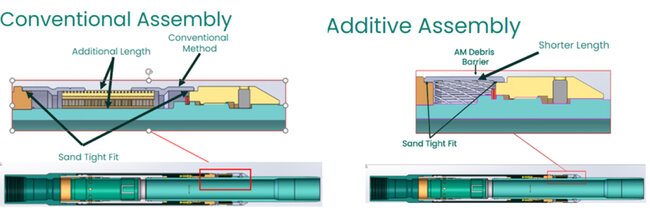
Lower Completions Debris Barrier
Additive Manufacturing Enhances design for Lower Completions Sand control screen.
The Debris Barrier screen, used in a lower completion production assembly, filters solid particles from the production zone. It allows fluids to enter the production tubing while preventing contamination of the production string.
Baker Hughes Additive Manufacturing (AM) produced a smaller, yet more efficient barrier screen using Ni 718 material in a laser powder bed fusion (LPBF) printer. The screen's cylindrical shape allowed the print chamber to be filled in both the x and y axes, while vertical stacking utilized the z-axis. This stacking provided the most efficient use of the build chamber, resulting in a lower individual part cost.
The final part was a robust screen with embedded structural ribs that increased collapse pressure resistance, while being shorter in length and retaining the required flow rate. The new design required less material per part and reduced the total number of parts to be assembled, making the process more timely and cost-effective. Sixteen parts were printed together in 42 hours, resulting in a shorter lead time of just four weeks.
Existing Design
Historically, the part was manufactured from 4.5” diameter nickel bar stock. A 30-foot length of bar material would be cut into segments, followed by cutting and milling activities. Support welding was then added to provide strength to the part. This process was costly, laborious, wasteful, and highly inefficient, resulting in lead times of over 15 weeks.
Validated Technology
Using additive manufacturing (AM), parts were built in four weeks and deployed to field operations. The design allowed for a drop-in replacement fit, with no alterations or modifications needed for the existing mating parts. The performance of the additively manufactured Debris Barrier proved superior to traditionally manufactured parts.
Efficiency Opportunity
- Increase collapse pressure resistance.
- Reduce the number of components of assembly.
- Increase reliability.
- Reduce/Eliminate screen hot erosion zones.
- Reduce manufacture lead time and installation time.
Design Challenges
- Critical tolerances for multiple filter slots.
- Rigid design in a smaller part.
- Drop-in replacement.
- Reduced tooling required to assemble filter into assembly.
Results
- Efficiency opportunities achieved.
- Optimized lead time to 4 weeks, a 75% reduction from the previous process.
- Inventory optimized by enabling minimum order quantity to fit the demand, avoiding inventory stocking, and eliminating risk of obsolescence.
- Reduced assembly time.



